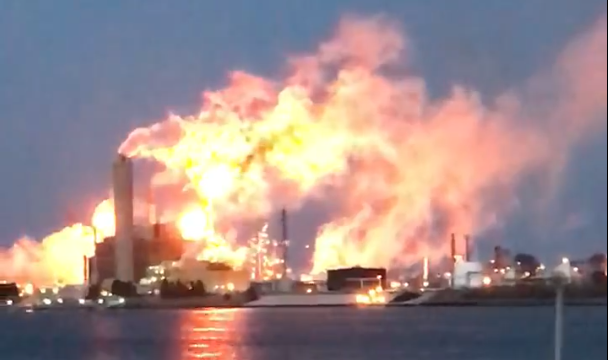After a lengthy investigation, the Ministry of the Environment announced in March 2019 that it would not charge Imperial Oil in the 2017 flaring incident.
In late February 2017, the skies above south Sarnia and Aamjiwnaang First Nation erupted in towering flames from Imperial Oil’s facility in Sarnia’s Chemical Valley — an area home to major petrochemical, energy and industrial facilities, where local residents are forced to breathe some of the most polluted air in Canada.
As massive flares rattled windows, created loud noises and pushed clouds of volatile organic compounds and sulphur dioxide into the air, local residents who contacted the Spills Action Centre, the Ministry of Environment and Climate Change, and Imperial Oil for more information about what was going on couldn’t get answers. The flaring continued on and off for ten days, leaving community members frustrated by the severe disruption to their daily lives and the lack of information on what chemicals were released from the flares and whether it could affect the health of their families.
Everyone should be able to trust the government to enforce the law when industry pollution impacts the health and well-being of neighbouring communities. Unfortunately, this is not always the experience for Vanessa and her community.
“We bear the cost of industrial pollution and spills every day. It can cost us our health, our lives, and the lives of future generations. This is part of Canada’s ongoing Indigenous genocide and the destruction of our traditional territory that has been going on for well over a hundred years.”
-Vanessa Gray
In October of last year, we helped Vanessa ask the Ministry to investigate whether Imperial’s flaring broke the law by affecting the health and well-being of community members. Now, more than a year after flames, black smoke and noxious fumes filled the skies of Vanessa’s community, residents are one step closer to getting an answer about what exactly happened that evening.
The investigation’s findings
Late last week, the Ministry handed down the results of the investigation it commenced in January 2018.
According to its findings, the concerns that we helped Vanessa bring forth are sufficiently serious to warrant a closer look by the Ministry’s Investigations and Enforcement Branch. The Ministry has now referred the file to the Branch to determine whether Imperial should be charged for the incident.
Although this incident was particularly egregious, excessive flaring is unfortunately commonplace in Chemical Valley. While flaring can, in some cases, be necessary for safety reasons, or occur in a planned manner when a unit is starting up or shutting down, too often flaring incidents in Chemical Valley are as a result of underlying malfunctions and result in smokey visible emissions of pollution that can be seen for miles.
We hope the Ministry uses this investigation as a starting point for a more proactive enforcement effort aimed at reducing the number of flaring incidents in Chemical Valley and other Ontario communities, and that it proactively investigates the impacts of major flaring incidents on nearby residents.
What’s next
There are approximately 57 major industrial polluters registered with the Canadian and U.S. governments within 25 kilometres of Sarnia. These facilities collectively emit tens of millions of kilograms of air pollutants each year.
That’s why Ecojustice has been helping community members who live near Chemical Valley for over a decade. Our efforts have contributed to charges laid and fines ordered against Shell Canada as a result of an incident in 2013, improvements in Ontario’s regulation of air pollution, and the investigation of spills and flaring incidents.
We firmly believe that regardless of race, geographic location, income or political connections, all Canadians have a right to a healthy environment. Governments should recognize and protect this right. It is unacceptable for the province to permit levels of air pollution that pose serious risks to health, or to deny residents access to information about the health risks posed by their industrial neighbours’ massive flaring.
It is also high time that our federal government amend our out-of-date toxics law the Canadian Environmental Protection Act, 1999 (CEPA) — which hasn’t been substantively changed in nearly 30 years. That’s why we continue to push the federal government to act on a report on CEPA reform tabled by the Standing Committee on Environment and Sustainable Development, which includes recommendations for binding national air quality standards, legal recognition of the right to a healthy environment, and greater protections for vulnerable populations.
We need stronger and more enforceable laws that better protect Canadians for generations to come.






